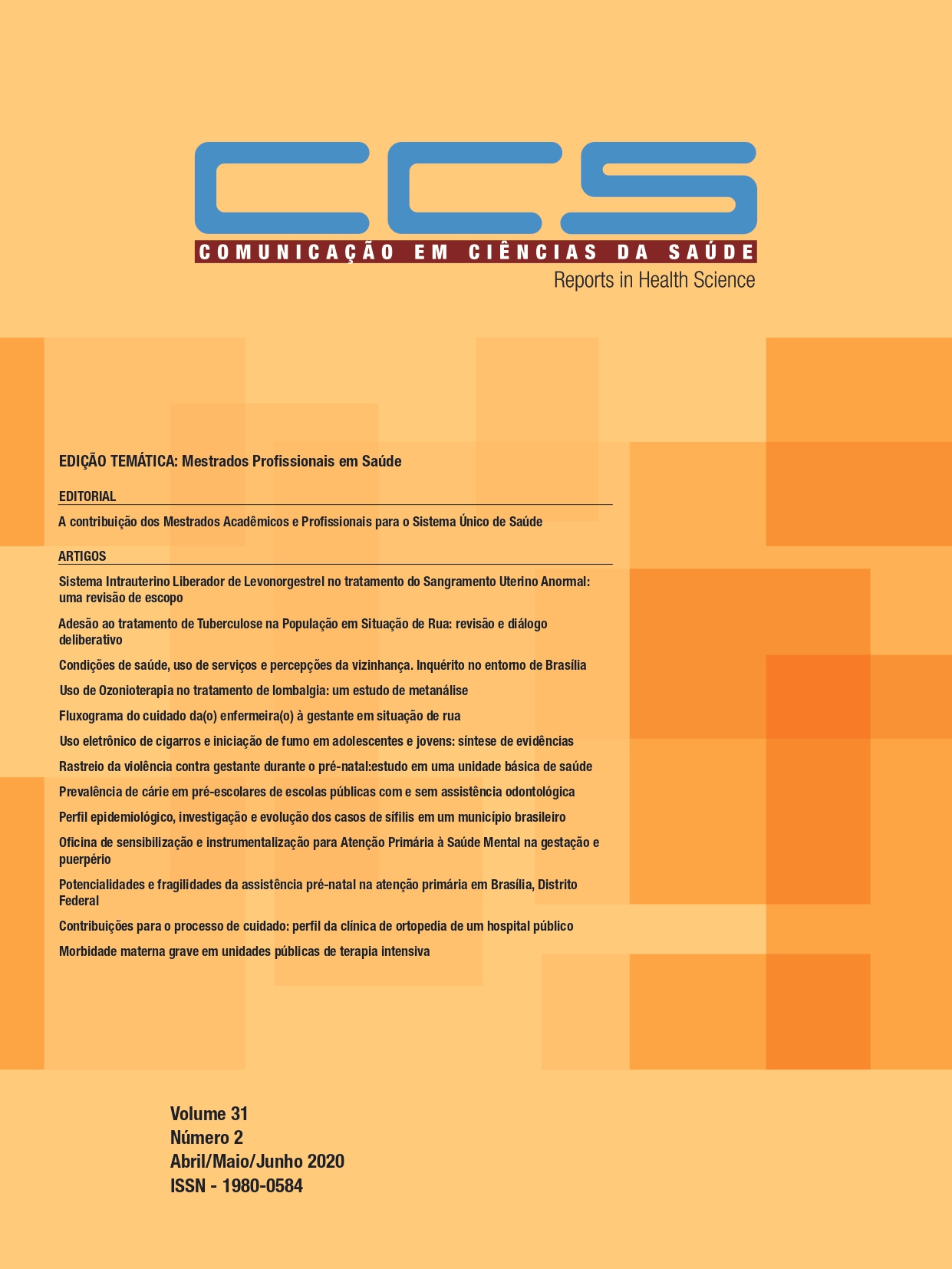Decay prevalence in preschool children from public educational institutions with and without dental care
DOI:
https://doi.org/10.51723/ccs.v31i02.607Palabras clave:
Dental caries, Pre-schoolchildren, Dental care for children, Public assistanceResumen
Objective: To evaluate the prevalence of dental decay in 5-year children, enrolled in schools, with (DC) and without dental care (NDC). Methods: DMFT index was used to assess caries. Family status were collected from parents. Results: Mean DMFT was 1.64 (57.3% free of caries). Less decayed teeth and more restored teeth were observed in DC (p <0.05). DC children have more access to dental services, although most parents had difficulty in taking them to a public service. Family incomes of up to 3 minimum wages have lower information about dental caries. Conclusions: DC did not influence the prevalence of tooth decay in children, but it significantly reduced dental treatment needs.
Descargas
Referencias
Kidd E, Fejerskov O. Changing concepts in cariology: forty years on. Dent Update. 2013; 40(4):277–278. doi: 10.12968/denu.2013.40.4.277.
Junqueira SR, Pannuti CM, Rode SM. Oral Health in Brazil - Part I: public oral health policies. Braz Oral Res. 2008; 22(suppl.1):8-17. doi: http://dx.doi.org/10.1590/S1806-83242008000500003.
Manton DJ. Child Dental Caries – A Global Problem of Inequality EClin Med. 2018; 1 3-4. DOI:https://doi.org/10.1016/j.eclinm.2018.06.006.
Çolak H, Dülgergil CT, Dalli M, Hamidi MM. Early childhood caries update: A review of causes, diagnoses, and treatments J Nat Sci Biol Med. 2013; 4(1): 29–38. doi: 10.4103/0976-9668.107257.
Martins MT, Sardenberg F, Vale MP, Paiva SM, Pordeus IA. Dental caries and social factors: impact on quality of life in Brazilian children. Braz. Oral Res. [online]. 2015, 29(1).
Tesser CD, Norman AH. Differentiating clinical care from disease prevention: a prerequisite for practicing quaternary prevention. Cad. Saúde Pública. 2016; 32(10):e00012316. DOI: http://dx.doi.org/10.1590/0102-311X00012316.
Anil S, Anand PS. Early Childhood Caries: Prevalence, Risk Factors, and Prevention. Front Pediatr. 2017; 5:157. doi:10.3389/fped.2017.00157.
Brazil. SB BRAZIL 2010: National Research on Oral Health: main results. Brasília: Ministry of Health, 2012. 116.
BIGS. Brazilian Institute of Geography and Statistics. Population Censures of 2014. Available in: www.ibge.gov.br/home/estatistica/populacao/estimativa2014/estimativa_dou_shtm.
Buzalaf MAR, Moraes CM, Olympio KPK, Pessan JP, Grizzo LT, Silva TL, Magalhães AC, Oliveira RC, Groisman S, Ramires I. Seven years of external control of fluoride levels in the public water supply in Bauru, São Paulo, Brazil. J. Appl. Oral Sci. 2013; 21 (1): 92-98. DOI: http://dx.doi.org/10.1590/1678-7757201302196.
World Health Organization. Oral Health Surveys Basic Methods 4th ed., 1997 (66 pages). Geneva: ORH/EPID, 1997.
Brazil. National Coordination of Oral Health. SB Brazil 2003 Project: oral health status of the population, 2002-2003 - main results. Brasilia: Ministry of Health, 2003.
Zemaitiene M, Grigalauskiene R, Andruskeviciene V, Matulaitiene ZK, Zubiene J, Narbutaiteet J, et al. Dental caries risk indicators in early childhood and their association with caries polarization in adolescence: a cross-sectional study. BMC Oral Health. 2016; 17(2):1-8. DOI:10.1186/s12903-016-0234-8.
Correa-Faria P, Paixao-Goncalves S, Paiva SM, Pordeus IA. Incidence of dental caries in primary dentition and risk factors: a longitudinal study. Braz Oral Res. 2016, 30(1):e59. DOI: http://dx.doi.org/10.1590/1807-3107BOR-2016.vol30.0059.
Martins MT, Sardenberg F, Bendo CB, Abreu MH, Vale MP, Paiva SM, et al. Dental caries remains as the main oral condition with the greatest impact on children’s quality of life. PLOS ONE. 2017; 12(10):e0185365. DOI: https://doi.org/10.1371/journal.pone.0185365.
Prabakar J, John J, Srisakthi D. Prevalence of dental caries and treatment needs among school going children of Chandigarh. Indian J Dent Res. 2016; 27:547-52. DOI: 10.4103/0970-9290.195683.
Shackleton, N, Broadbent, JM, Thornley, S, Milne, BJ, Crengle, S, Exeter, DJ. Inequalities in dental caries experience among 4‐year‐old New Zealand children. Community Dent Oral Epidemiol. 2018; 46:288–296. DOI: https://doi.org/10.1111/cdoe.12364.
Huebner CE, Chi DL, Masterson E, Milgrom P. Preventive dental health care experiences of preschool-age children with special health care needs. Spec Care Dentist. 2015; 35(2):68–77. DOI:10.1111/scd.12084.
Naidu R, Nunn J, Donnelly-Swift E. Oral health-related quality of life and early childhood caries among preschool children in Trinidad. BMC Oral Health. 2016; 16(1):128. DOI:10.1186/s12903-016-0324-7.
Amiresmaili M, Amini S, Shahravan A, Goudarzi R, Hossein S, Anari S, et al. Relation between Socioeconomic Indicators and Children Dental Caries in Iran: A Systematic Review and Meta-analysis. Int J Prev Med. 2018; 9:71. DOI:10.4103/ijpvm.IJPVM_435_17.
Archivos adicionales
Publicado
Versiones
- 2020-10-05 (3)
- 2020-10-02 (1)
Número
Sección
Licencia
Declaro para os devidos fins que o artigo que estou submetendo representa um trabalho original e nunca foi publicado total ou parcialmente, e que se alguma de suas partes foi publicada possuímos autorização expressa para a publicação no periódico Comunicação em Ciências da Saúde (CCS). Esse artigo não foi enviado a outro periódico e não o será enquanto estiver sendo considerada sua publicação; caso venha a ser aceito não será publicado em outro periódico; e não contém material difamatório ou ilegal sob nenhuma forma, não viola a intimidade de terceiros, nem infringe direitos protegidos.
Eu e demais autores desse trabalho certificamos por meio desta declaração que:
- Concordamos com as normas editoriais e com o processo de revisão da CCS;
- Aceitamos a responsabilidade pela conduta desse estudo e pela análise e interpretação dos dados;
- Cooperaremos, sempre que solicitado, na obtenção e fornecimento de dados sobre os quais o manuscrito está baseado, para exame dos avaliadores;
- Não estão sendo omitidos quaisquer ligações ou acordos de financiamento entre os autores e companhias ou pessoas que possam ter interesse no material abordado no artigo;
- Não estão sendo excluídos ou omitidos deste artigo autores ou instituições participantes;
- Possuímos permissão para uso de figuras e tabelas publicadas em outras fontes;
- Possuímos permissão das pessoas e instituições citadas nos agradecimentos;
- O autor correspondente autoriza a publicação do endereço informado e e-mail do(s) autor(es) junto com o artigo;
- Assumimos a responsabilidade pela entrega de documentos verídicos;
- Autorizamos a publicação do referido artigo no periódico Comunicação em Ciências da Saúde, segundo critérios próprios e em número e volume a serem definidos pelo editor do periódico;
- Nos comprometemos a atender os prazos estipulados pelos editores do periódico Comunicação em Ciências da saúde;
- Estamos cientes de que a não manifestação no prazo de dois dias da revisão da diagramação, recebida por e-mail, será considerado aprovado para publicação.








